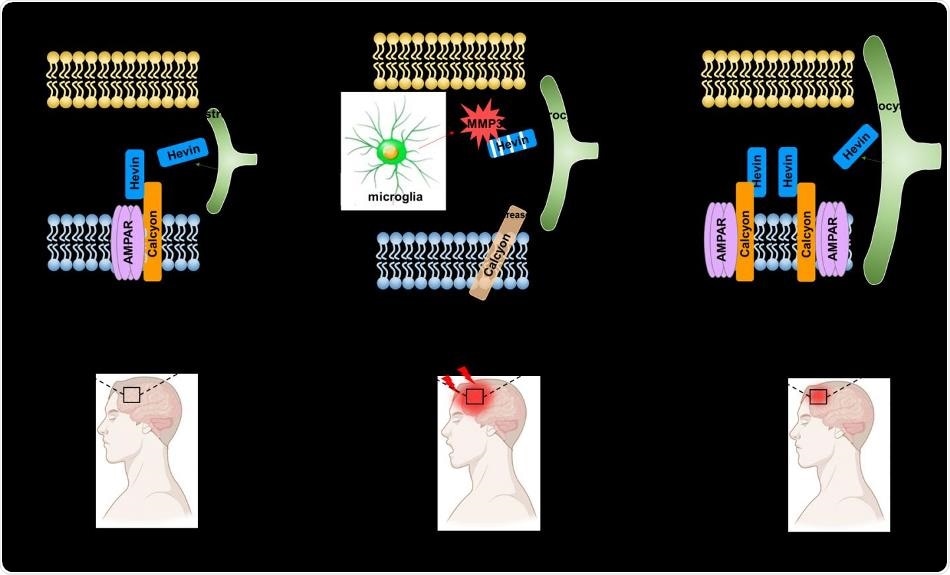Patients suffering from brain damage (induced by trauma or stroke) largely depend on rehabilitation therapy for recovery, because no other effective treatment options are available.

Mechanism of action of inflammatory activation enzymes of Hevin-calcyon interaction. Image Credit: Korea Institute of Science and Technology (KIST).
In adults, the rate of recovery from brain damage is substantially slower (or the recovery is even impossible) than that seen in young children. Researchers agree that the number of extra neural stem cells that can restore brain functions is lower in the case of a mature brain when compared to the brain of young children.
A research team from Korea has reported a unique mechanism to explain the healing process of brain injury. When the animal model experiment was carried out, the researchers found that the time needed to recover from brain damage could be regulated by controlling the proteins.
The Korea Institute of Science and Technology (KIST) has announced that a research team, headed by Dr. Eun Mi Hwang from the Brain Science Institute at KIST, has collaborated with another team headed by Professor Kyoungho Suk from the School of Medicine at Kyungpook National University, These researchers have reported the presence of a new interaction between proteins (hevin-calcyon) which plays a major role in the early phases of recovery.
Working at KIST, they also discovered that the calcyon protein is a new interacting partner of hevin—a specific protein produced by glial cells in the brain. The team further discovered that inter-protein interaction was crucial in the healing process of neuronal cells present in an impaired adult brain. Since neurons are cells that have a direct impact on brain function, it is assumed that brain disorders can be treated when they are recovered and/or treated.
Glial cells essentially support the tissues in the central nervous system, supply nutrients to neurons within the brain and spinal cord, and produce a chemical environment conducive to neural activity.
The results of the studies revealed that increasing the number of hevin-calcyon interactions in the brain could support the contacts and reorganization of synapses, which could aid in the early recovery of the damaged brain.
By examining healthy brain tissues, the researchers were able to validate the hevin-calcyon connection and the expression of these proteins. It was also noted that the number of interactions in individuals with traumatic brain injury was considerably reduced.
Using a brain injury animal model, the researchers from Kyungpook National University investigated the healing process of brain damage by analyzing the hevin-calcyon interaction. They discovered that proteases, induced by a neuroinflammatory response and developed in the early stages of brain damage, caused the fragmentation of hevin.
This process also prevented the formation of hevin-calcyon interaction. Experiments were carried out on an animal model of brain damage which revealed that the healing time could be shortened to around two to three weeks (from four weeks) by directly administering an inflammatory response inhibitor to the brain’s injured region. The recovery rate could be further slowed down by injecting another inflammatory protein.
The combined research group reported that the lack of hevin-calcyon interaction in the early stages of the healing process (a crucial phase in the recovery process of brain damage) may have a detrimental effect on the effective recovery process.
These results are the outcome of five years of persistent studies undertaken by teams headed by Dr Eun Mi Hwang from KIST (the research team that identified the novel protein interaction), the team headed by Dr. Hoon Ryu from KIST (this research team studied human traumatic brain injury), and the team headed by Professor Kyoungho Suk from the Kyungpook National University (this research team investigated the properties of inflammation using numerous animal models). Based on their areas of expertise, each team contributed to these findings.
The hevin-calcyon interaction can potentially help in treating brain diseases as brain injury and neurodegenerative diseases can result in the generation of inflammatory responses. The findings can potentially help in the development of procedures for treating refractory brain diseases caused by impaired synaptogenic activity.”
Dr Eun Mi Hwang, KIST
Source:
Journal reference:
Kim, J-H., et al. (2021) Hevin–calcyon interaction promotes synaptic reorganization after brain injury. Cell Death & Differentiation. doi.org/10.1038/s41418-021-00772-5.